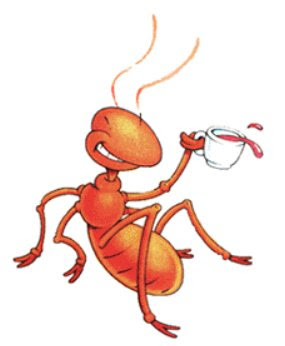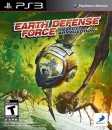We all know ants are incredibly capable creatures. They live in vast, interconnected colonies, can lift several times their own body weight, and coordinate their activity with incredible precision.
But many of the things that make ants impressive would also make them formidable foes. Perhaps it's time we took a look at some of these strengths in greater detail. Remember: it's important to know your enemy - erm, I mean your new insect overlords.
10) Ants are as old as the dinosaurs
In 2006, Scientists from Harvard and Florida State University collaborated to conduct a massive genetic analysis on ants from 19 out of 20 known subfamilies. Their findings suggested that ants first arose in the mid-Cretaceous period — about 110—130 million years ago. And yes, that means:
 9) Ants have already survived a mass extinction event
9) Ants have already survived a mass extinction event
The Cretaceous-Paleogene extinction event (still commonly referred to as the Cretaceous-Tertiary — or "K-T" — extinction event) is thought to have occurred approximately 65 million years ago following an absolutely massive impact event. Widely regarded as the downfall of the dinosaurs (and, incidentally, the rise of mammals), the years following the KT-extinction event are actually believed to have been a time of incredibly rapid speciation and worldwide expansion for ants, marking what researchers Bert Hölldobler and Edward O. Wilson — authors of the Pulitzer-prize winning book The Ants — call "a rise to ecological dominance." [Illustration by Don Davis via]
8) Ants have conquered almost the entire globe
The success of the ants all those millions of years ago continues to this day. In an article published in a 2000 issue of PNAS, entomologist Ted Schultz calls the rise of the ants "arguably the greatest success story in the history of terrestrial metazoa" ( i.e. pretty much any multicellular animal on Earth — and yes, that includes humans), and rightfully so.
With the exception of Antarctica, the Arctic, and a handful of islands, just about every piece of land on Earth harbors at least one native ant species; the ones that don't host invasive species. Take the Hawaiian islands, for instance — not one of their more than 50 established ant species is believed to be native to the archipelago.
 7) One group of ants conquered six continents
7) One group of ants conquered six continents
Take the Argentine ant, Linepithema humile, for example. In 2000, biologists Andrew Suarez and his colleagues at UC Davisreconstructed the invasion history of the L. humile. The team revealed that in the last century alone, the species has become established in at least 15 countries throughout the world — including a number of isolated, oceanic islands (including Hawaii) — spanning six continents. Shown here is the world distribution of the Argentine ant. [figure via]
6) The total ant population makes our 7 billion look weak
In their Pulitzer-prize winning book The Ants, researchers Bert Hölldobler and Edward O. Wilson estimate that there are upwards of 10,000,000,000,000,000 individual ants alive on Earth at any given time.
 5) Some ants are quite large
5) Some ants are quite large
Of course, even at numbers exceeding 10,000 trillion, ants are small, right? Well, that depends entirely on what you consider small. The largest ant ever discovered was actually a fossilized specimen belonging toTitanomyrma giganteum, was about 2.4 inches long and had a wingspan of almost six inches. Granted, T. giganteumisn't around anymore, and many ants are less than a millimeter long — but there are still species like the African driver ant, Dorylus wilverthi, that exceed two inches in length. Does that sound small to you?
4) Ants have a hive mind
Truth be told, it doesn't matter if it sounds small to you or not. When 50-million of them come together to form a single, eerily coordinated superorganism (and yes — large, self-organized ant colonies are commonly referred to as "superorganisms") you can bet your ass you'll think it looks a lot bigger than a single, 2-inch ant.
 3) In some regions of the world, ants can account for over a quarter of the animal biomass
3) In some regions of the world, ants can account for over a quarter of the animal biomass
But a 50-million ant superorganism, believe it or not, doesn't even begin to capture the true extent of the global ant presence. We're talking about worldwide ant domination, after all — so how much of the Earth's biomass do ants really account for? [Ant attack via]
In an article published in 2000 inProceedings of the National Academy of Sciences, entomologist Ted R. Schultz writes that on average, ants "monopolize 15—20% of the terrestrial animal biomass, and in tropical regions where ants are especially abundant, they monopolize 25% or more."
Granted, it would be misleading to say that ants have the largest biomass of any individual species on Earth (ants are actually a taxonomic Family that comprises over 20,000 known species) — but that's not to say they couldn't potentially set aside their interspecies differences. After all:
2) Ants cooperate with other species
There are over 200 known species of so-called fungus growing ants. Scientists had long assumed that fungi cultivated by these ants were simply passed on between generations within individual species. But in a study conducted in 2000, researchers at the University of Texas at Austindiscovered that the ants' cultivars are occasionally transferred between species, as well.
Interspecies cooperation would be one of the biggest hurdles along the path to establishing a global ant empire — but if fungus-growing ants can get along, perhaps other species could as well.
Then again, maybe cooperation wouldn't be necessary, because:
 1) Ants practice slavery
1) Ants practice slavery
Many species of ants are known to raid neighboring colonies and steal eggs or larvae in a practice known as "dulosis". The forcibly acquired young are then either eaten or put to work.
Species that practice dulosis are called, quite simply, "slave-making ants," and they rely on this practice to support their colonies. In fact, some species of ants are thought to beincapable of feeding themselves in the absence of slave labor — to pillage and enslave is all they know.












































































